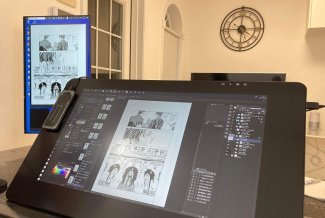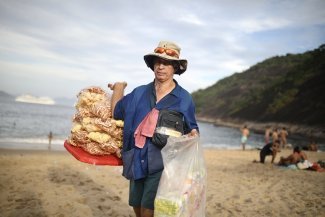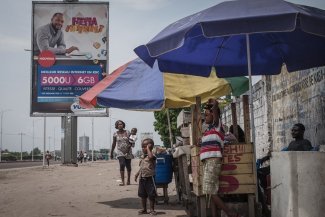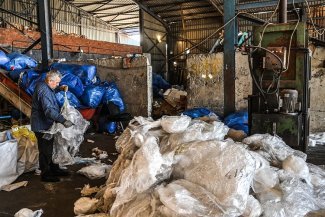To date, the conflict has claimed 277 lives and caused more than 2,000 injuries but it has also affected the various sectors of production, the labour market and poverty rates.
Nicaraguans weep for their young people, for their chavalos (kids). It is no coincidence that young people account for the lion’s share of the deaths, since the conflict started in various university campuses: the Polytechnic University of Nicaragua, the National University of Engineering (UNI) and the Central American University (UCA). The lists of the deceased show that the vast majority of the dead were men under 30.
"After 11 years, we have no more fear. This is what young people were saying outside of the university," recounts Iván Matus, a young man who witnessed the first armed attack of the conflict from within the Polytechnic University of Nicaragua.
"The fact that the first death happened within the grounds of the Polytechnic University of Nicaragua acted as a catalyst. The whole country was outraged by this and lots of us came down to the university, all of our own volition. The way they killed this man was brutal. They chased him and shot him from one meter away. The images were grotesque. I felt angry. For 11 years, we remained silent under an authoritarian regime with the potential to turn into a dictatorship. People were afraid and apathy was prevalent because they believed that there was economic stability to a certain extent, that there was work, that there was some kind of benefit, which made them say: "Well, we are better off than before". But in reality people were dissatisfied. I think the fact that the first people killed were aged 20, 18 and even 15, the fact that they were killing young people without scruples and without any kind of remorse made the public backlash even greater," says Matus.
According to Matus, the students occupied the Polytechnic University to barricade themselves inside after they were met with brutal repression by the authorities and groups of the Sandinista Youth (associated with the government). It started off with 20 students but at one stage they numbered more than 300. At first, the riot police used rubber bullets and tear gas but they then moved on to live bullets. They attacked with the intention of killing.
The young people had no strategy; they had barricaded themselves in the university but they had no real weapons, only home-made mortars and stones. Soon after, they began gathering supplies – medicine, food and water – and organising medical teams with the support of medical students, since public hospitals would not receive the injured and the Red Cross was not operating, following what the protesters presumed was an order from the state.
"The only reason there wasn’t a massacre that day [19 April] was that in the end so many people from the community came out and started to block the streets and make barricades to defend the university. They said "We’re not going to leave the chavalos on their own"," Matus recalls.
The violence did not take long to escalate. One of the deadliest events took place on 30 May: snipers fired at will at a Mother’s Day march attended by around half a million people. A month later, on 6 July, a family burnt to death in a fire that the government and opposition both blame on each other.
As well as the shootings, other incidents have been reported. To date, these include cypermethrin (insecticide) attacks on communities carried out by light aircraft, sulphuric acid attacks, arbitrary arrests, kidnappings and torture. According to a report from the Inter-American Commission on Human Rights (IACHR), those most affected are students, human rights defenders, journalists and members of the religious community.
Reform of the pension system – state coffers plundered
A presidential decree to reform the pension system of the Nicaraguan Social Security Institute (INSS) and increase contributions sparked outrage among the population, which is why Nicaraguans took to the streets on 18 April in peaceful protest as part of a movement calling itself #SOSNICARAGUA. This peaceful protest quickly turned into the bloodiest political and human rights crisis that the country has seen since the Sandinista Revolution.
The decree would raise contributions from 7% to 11% for the optional incapacity, old age and death schemes, and to 17% for the comprehensive scheme, as well as cut pensions by 5%. These changes would affect private companies and, in particular, the citizens of Nicaragua, roughly 40% of whom live in poverty according to estimates from the European Commission.
The government justified the increase in contributions by the need to ensure the sustainability of the INSS after declaring that the institution had been plundered by the previous three governments. These statements are disputed by the protesters, who claim that the current government (in power since 2007) has embezzled the state finances.
As a result of this situation, to date there have reportedly been 277 deaths, more than 2,000 injuries and 215.000 job losses, with 1.3 million people at risk of falling into poverty (in a country of just over 6 million inhabitants) and around US$250 million (some €214 million) in losses, according to data from the IACHR, the Nicaraguan Centre for Human Rights (CENIDH) and the Nicaraguan Foundation for Economic and Social Development (FUNIDES).
What if Daniel Ortega steps down? And what if he stays in power?
There are two possible scenarios: either the crisis ends or it gets worse. In other words, either Ortega - the current president - temporarily steps down, or his "regime" remains in power and "repression increases to contain the wave of popular discontent". This was confirmed by CENIDH director Vilma Núñez when she spoke with Equal Times by telephone from Nicaragua in early May. At that time, the national round table was being set up under the leadership of the Episcopal Conference of Nicaragua.
However, this effort was unsuccessful, with the Episcopal Conference pulling out on the grounds that the required conditions were not in place for work to proceed or for a Verification and Security Commission to be established. As well as threats to representatives of civil society, the priest José Alberto Idiáquez, rector of the Central American University (UCA) and one of the main proponents of the peaceful demonstrations, received death threats, which was confirmed when the IACHR provided protective measures.
Finally, there was a general feeling that the government was applying double standards, on the one hand apparently being open to dialogue, while on the other hand violently repressing the population. As such, neither scenario is certain.
According to FUNIDES, which has monitored the impact of the sociopolitical crisis on the country’s economy, if an end to the crisis were to be negotiated by the end of July, with an understanding reached on the issues of justice and democratisation and an end to the repression, violence and public insecurity – which would entail Ortega’s resignation – economic activity in 2018 would contract 0.03% compared to the 2017 financial year, and losses would reach $638 million (around €550 million) in value added. If Ortega were to remain in power and the crisis were to intensify in the second half of the year, economic activity would contract 5.6% and losses would double to $1.4 billion (around €1.2 billion). Furthermore, FUNIDES expects tens of thousands of job losses, mainly in the catering sector, closely followed by the trade, construction and manufacturing sectors.
The government of Nicaragua announced its position on 4 June in Washington D.C. (USA) at the 48th General Assembly of the Organization of American States (OAS). In the Declaration of Support for the People of Nicaragua, representatives of the Central American country accepted the support of the OAS and the intervention of the IACHR. The websites of the institutions of the government of Nicaragua (Ministry of Foreign Affairs, Office of the President and Ministry of Finance) are not working at this time, nor can the press officers be contacted.
Silence, darkness and fear
From 5 p.m. onwards, Nicaragua’s capital Managua is like a ghost town, as though a curfew were in place. People are afraid to leave their homes; in neighbourhoods, armed groups are firing shots, and there is fear, uncertainty and general panic.
On 5 July, the Office of the United Nations High Commissioner for Human Rights confirmed that armed groups associated with the government were roaming the streets, intimidating citizens. "My team heard accounts of deep frustration and despair, as well as general fear. Real guarantees need to be put in place to ensure that people can exercise their rights to freedom of expression, assembly and association. Victims’ rights to the truth, justice and compensation must also be guaranteed. I urge the state to ensure that effective, independent, impartial and prompt investigations are conducted to establish the truth and ensure accountability for the violations and abuses committed since April," declared Zeid Ra’ad Al Hussein, United Nations High Commissioner for Human Rights,in a statement.
After attempts to establish a round table failed, the last option remaining appears to be in the hands of international players. Following a visit to verify the situation, the IACHR produced 15 recommendations on how to stabilise the country and, on 24 June, it set up the Special Monitoring Mechanism for Nicaragua (MESENI) and prepared the launch of the Interdisciplinary Group of Independent Experts (GIEI) for Nicaragua.
The OAS also issued a resolution on 18 July with the support of 21 countries of the Americas, strongly condemning the events and calling on the state to establish an electoral calendar so as to hold new elections. The European Union added its voice to the chorus of disapproval with a similar announcement two days earlier, in which it called for a peaceful and democratic solution to the conflict.
The IACHR team – the only one in the field – will be responsible for monitoring compliance with the protective measures put in place for multiple actors in the conflict and will assist the Verification and Security Commission so that the state can investigate the violations that have occurred since 18 April and establish the liability of those who reputedly committed the killings, acts of torture and multiple other disturbances.
At the moment, events are still unfolding. On 17 July, the Office of the United Nations High Commissioner for Human Rights reported a crackdown in cities such as Masaya and Monimbó called "Operación Limpieza" (Operation Clean-Up), and attacks continue to be made against those involved in national dialogue, especially priests. According to estimates from Nicaragua’s Civil Alliance for Justice and Democracy, there is a new fatality every six hours.










